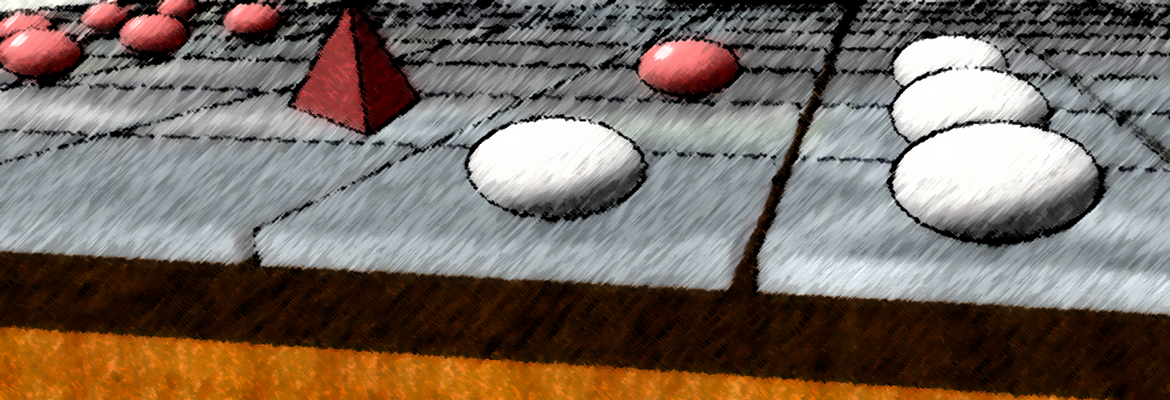Luductus
The room was empty except for a Luductus-Board right in the middle, left there in the middle of a game. Decadus Saturio Pascentius ordered his men to spread out in the house in standard formation, gladium in hand, and a hand on his flintlock pistol on his side he edged closer to the board. The red pieces were surrounding the opposite player, who made the mistake of being boxed in in the middle in a standard bull formation.
Unusual was their dark blue color which was painted on - Saturio could make out the typical white color shining through the still wet paint.
With a chill down his spine he looked at the blue overcoats of his Decady.
Luductus is a very popular board game originating in ancient Ethoras, where it was supposedly played by soldiers and spread across The Ethorial Lands due to them. It is a game of strategy without any elements of chance. The goal of the game is to either capture all opposing pieces or box in the contrahent's leading piece, the Praetorian.
Though developed roughly twothousand years ago, the basic game rules are still used widespread, but more complex variants have been developed, adding to the number of pieces or changing the shape of the board.
Being highly valued as a game of strategy and thinking ahead, it is common form for any officier in the Keandran Millitary(organization) to be proficient in this game. It was often used to discuss strategy and tactics in upcoming battles, though this practice has been abbandonned due to rapidly changing scale of warfare in the last decades.
In Baradolia, Ethoressi and the Kingdoms of Sevelang as well as Rhomedan there are several luductus-leagues with annual tournaments, being valued as a feat of intelligence to master this game on the more complex levels.
Though developed roughly twothousand years ago, the basic game rules are still used widespread, but more complex variants have been developed, adding to the number of pieces or changing the shape of the board.
Being highly valued as a game of strategy and thinking ahead, it is common form for any officier in the Keandran Millitary(organization) to be proficient in this game. It was often used to discuss strategy and tactics in upcoming battles, though this practice has been abbandonned due to rapidly changing scale of warfare in the last decades.
In Baradolia, Ethoressi and the Kingdoms of Sevelang as well as Rhomedan there are several luductus-leagues with annual tournaments, being valued as a feat of intelligence to master this game on the more complex levels.
Rules
The exact rules vary from region to region - the size of the board and the number of pieces can differ as well as the movement abilities of the pieces. What is described here are the most commonly known rules in Keandra, where the game is most popular.Setting up
The board for each Luductus game is comprised of a field of 7 rows and 13 columns, the players own 12 pieces in red or white color, respectively. One of the twelve pieces is specially marked to denote it as a Praetorian, the leading piece of each side, while the others are the legionaers. Typically the legionaeres are small rounded stones while the praetorian is often a tetrahedron.
In the beginning of the game, the player take alternate turns to place their pieces within the first two rows of their side in any way they like, with red starting first. The Praetorian has to either be set as the very first or the very last piece, which the player decides at the beginning of his turn.
In the beginning of the game, the player take alternate turns to place their pieces within the first two rows of their side in any way they like, with red starting first. The Praetorian has to either be set as the very first or the very last piece, which the player decides at the beginning of his turn.
Lielle glanced at her opponent and tried to read his face. The set up phase was almost completed and she already felt like this bastard was mocking her. Using the traditional opening against a player of her class in this important tournament? She already knew of about twenty ways to paralyze his beginning moves, as every grandmistress would. This was ridiculous, she thought, as she set down her next piece, looking forward to see the grin fade away from his stupdily bearded face.
Movement
Starting with white, who placed the last piece on the board, the players must move one of their pieces in vertical or horizontal direction. The legionaeres and preatorian can move as many fields as they want, as long as the target field and all fields in between are not blocked by another piece. The praetorian additionally can jump over any of its own legionaires if they are next to him at the beginning of the turn and the field on the other side is free of pieces.
There is no diagonal movement.
There is no diagonal movement.
This felt more like a game of cat and mouse and less like a game of luductus. Gregor frowned as he saw his opponent drawing his preatorian back once more out of almost certain deadlock. He had prepared a nice little zig-zag-row of his own pieces, to jump the praetorian back and lure Gregor's own praetorian further. Most of Gregor's other pieces were locked however and he would have no other choice but to engage. He looked up and saw a slight twitch in his opponent's beard reveal his amusement. Unless he would find another elegant move, he would continue to be played by him like a fiddle.
Taking Pieces
To take a legionaere, it needs to be boxed in by the player's own pieces on both sides in any direction. This means the piece is either boxed in horizontally, vertically or diagonally by two opposing pieces.
Capturing a piece
However, the taking side needs to create such a situation. If a player moves his legionaere into a boxed position, it will not be taken. This move is called a fortification.
Fortification
It is possible to capture an entire row of legionaeres when they are boxed in. This is not possible if the praetorian is in this row.
A curse came over Temares' lips. He did not pay enough attention and now four of his legionaeres were gone, just like that. And with them all the silver daenare under the stones, as they were part of the wager. How could he explain to his wife that he lost all their money to a bearded fool who kept losing all night to everybody else? The dreadful realization came to him as the grin of his opponent as he bit triumphantly on the coin, was shared by several of the surrounding onlookers.
To take the praetorian it needs to be completely boxed in on all four sides by enemy pieces, so it is no longer able to move. This is obviously much easier on the border or the corner of the board. Taking the praetorian ends the game.
End of the game and winner
The game ends, if- all legionaeres of a side are taken,
- the praetorian of a side is taken,
- a player still has pieces but is unable to make a move in their turn or
- there has not a single piece been taken for the last thirty turns.
In the first two cases winner is the player that successfully took the opposing pieces. In the last case the player with the most pieces left wins. If the number is the same, the game ends in a stalemate. The third case is rare but possible, since legionaeres are protected from being taken through the border and in a row with a praetorian. If a player cannot make a move, he is considered "starved out" and loses the game.
The culprit is known to hide in this house and as far as we know, he is alone. Operate under highest caution, we are aware of at least five victims in the past year that he first humilated with a game, then stalked and later disposed of. We will bring the imperator's justice to this maniac luductus player and I want to see the grin on his stupid bearded face fade, when he is facing the highest punsihment. I will see you and your Decandy later, Decadus Pascentius!
Manufacturing process
In the simplest version, a game of Luductus is easily fashioned: Keandran soldiers would collect some small stones of two distinct colors or two distinct forms, sometimes have special stones or coins for a preatorian and draw a board in the sand.
Manufactured sets are mostly made out of furnished wood with polished playing stones, sometimes with inset gems.
Manufactured sets are mostly made out of furnished wood with polished playing stones, sometimes with inset gems.
Item type
Miscellaneous
Owning Organization
Raw materials & Components
One board of 7 x 13 fields, number varying but always with uneven columns.
24 game stones, 12 of each color, with a special piece per color having a distinctly different form or some kind of mark.
24 game stones, 12 of each color, with a special piece per color having a distinctly different form or some kind of mark.














Comments
Author's Notes
This game is inspired by and based on a roman version of chess, called latrunculi, the "game of mercenaries". The basic game concept is the same but with some slightly changed rules. - Which should not be an issue anyway, since the original game itself was changed and modified a lot, depending on the available pieces and alcohol level. This Article is an entry for the February 2018 Master's Challenge "Snake Eyes!"